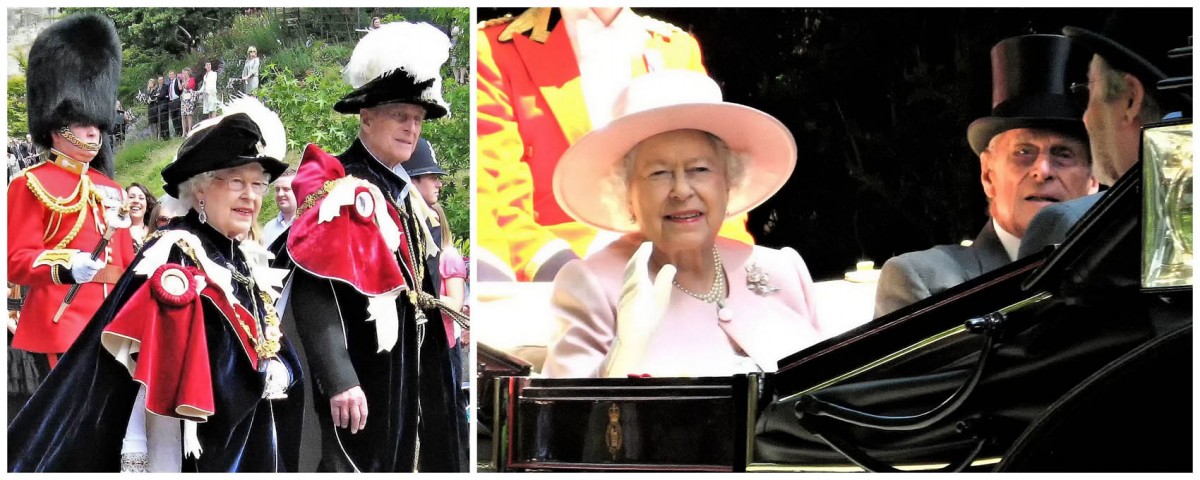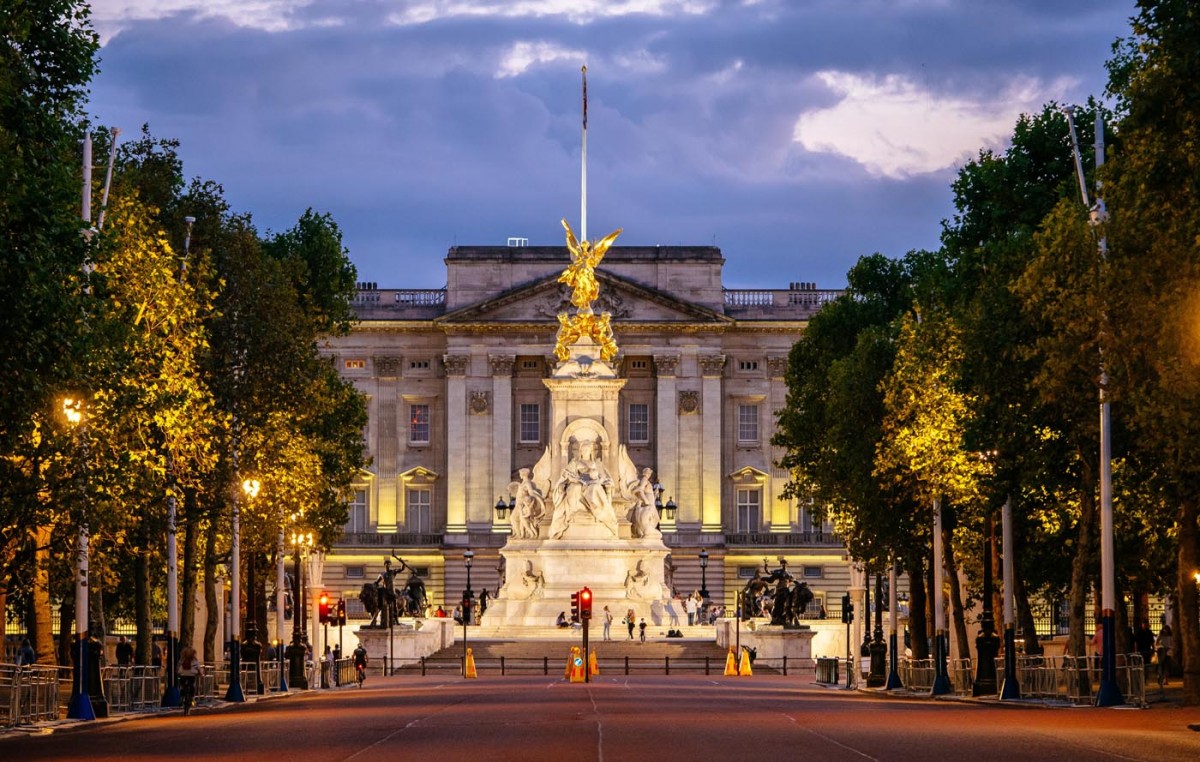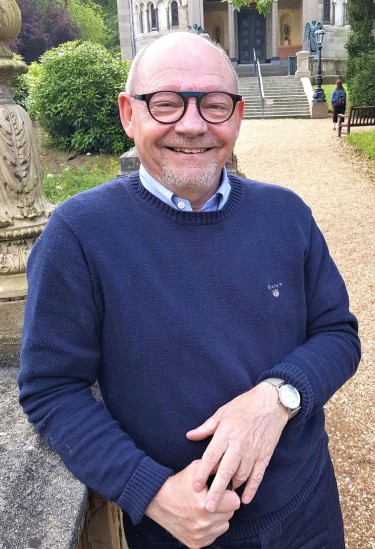His Royal Highness The Prince Philip, Duke of Edinburgh, who died at Windsor Castle on 9 April, just seven weeks short of his 100th birthday, earned the distinction of being the longest lived male member of the British royal family. He was also the longest married and the longest serving royal consort in history.
For more than six decades he had been a prominent, sometimes controversial, but always highly visible and innovative figure not only in British national life, but internationally. Half a world away, on the Pacific Vanuatuan island of Tanna, he was even regarded as god-like, a ‘recycled’ descendant of a powerful spirit that lived in one of the island’s mountains. There, among the villagers, with whom Prince Philip kept in touch over the years, his passing was being mourned every bit as keenly as it was at home.

Her Majesty and Prince Philip at Garter Day at Windsor Castle in 2012, and on their way to Royal Ascot in 2014
Ancestry
Scion of the house of Schleswig-Holstein-Sonderburg-Glücksburg, a collateral branch of the North German/Danish house of Oldenburg, Philip or Philippos of Greece and Denmark was born sixth in line to the Hellenic throne on 10 June 1921. His birthplace was the dining room, or to be precise, the dining room table, at Mon Repos, a cream stucco ‘villa’ atop Analipsis hill, in the forest of Palaeopolis, on the island of Corfu.
A maternal great-great-grandson of Queen Victoria, Philip’s mother was Princess Alice of Battenberg, the elder daughter of Princess Victoria of Hesse and by Rhine and Prince Louis of Battenberg. Congenitally deaf (she learnt to lip-read and speak in five languages), Princess Alice was diagnosed in mid-life with paranoid schizophrenia, spending prolonged periods in Swiss and Italian sanatoria, separated for most of his youth from her only son and his four elder sisters, all of whom in their mother’s absence, would marry princes of Hanover, Hesse and by Rhine, Hohenlohe-Langenburg and Baden.
Prince Philip’s father, Prince Andrew of Greece and Denmark, was the fourth son of the Danish-born King George I and his queen, the Russian Grand Duchess Olga Konstantinovna. In the late summer of 1922, during the revolution that followed the Greek army’s defeat in the three-year war with Turkey, Prince Andrew who came close to being executed for his disobedience as a commanding officer, was court-marshalled and permanently banished from his homeland. With the help of King George V who sent HMS Calypso to rescue them, Prince and Princess Andrew, their infant son, Philip, whose makeshift cot was an orange box, and their daughters sailed for France and exile.
It was the start of Prince Philip’s nomadic youth. At the age of six - with his father living with his mistress on the French Riviera and his mother in sanatoria - the young prince was brought to England by his grandmother, now the Dowager Marchioness of Milford Haven, to be educated at Cheam preparatory school. At twelve he was dispatched to Germany and Schloss Salem, a school that was owned by his sister Theodora’s husband, Berthold, the Margrave of Baden. A year later he was back in the UK, in Scotland, continuing his education at Gordonstoun in Morayshire. Its Spartan, character-building regime, devised by his previous headmaster, Kurt Hahn, suited Philip well and on merit he went on to be appointed ‘Guardian’ or Head Boy.
Naval Years
Following in the footsteps of his grandfather, Louis of Battenberg, 1st Marquess of Milford Haven, who until the start of the Great War had been First Sea Lord, and his uncles George, later 2nd Marquess of Milford Haven and ‘Dickie’, Lord Louis (afterwards Earl) Mountbatten, Prince Philip’s sights were firmly set on a naval career. And famously, it was at Britannia Royal Naval College, Dartmouth, in July 1939, that the eighteen-year-old Special Entry Cadet first met his future wife, Princess Elizabeth, then but a girl of thirteen, when she and her sister Princess Margaret accompanied their parents, King George VI and Queen Elizabeth on a pre-war visit to the College.

The Britannia Royal Naval College (top left) in Dartmouth. Image by ALEX GRAEME
For Philip this was not only the start of a promising naval career that would eventually lead to his having command of his own ship, the frigate HMS Magpie, but also the overture to a marriage – so ambitiously encouraged by his uncle Dickie Mountbatten that at one stage Philip had to tell him to stop interfering – that would prove to be every bit as important as that of their mutual great-great-grandparents, Victoria and Albert. From around the time of their first meeting at Dartmouth, Philip and Elizabeth or ‘Lilibet’ as she was known within the family, began writing to one another.
Later, during the years of the Second World War, in which Philip was mentioned in dispatches during the Battle of Cape Matapan, they would meet at Windsor or at the nearby home of his first cousin, Marina, Duchess of Kent, when he was home on leave. From those early beginnings grew the love that led in November 1947 to a marriage that, while not whole-heartedly approved by certain members of the royal family, would last for the next seventy-three years.
Public and Private Life
Philip, who had become Duke of Edinburgh, and Princess Elizabeth had been married little more than four years when the sudden death of King George VI on 6 February 1952, changed their lives irrevocably; effectively pulling the rug from under their hopes of at least several more years of family life with their two young children, Charles and Anne, before being called upon to fulfil the princess’s ultimate destiny.
With his wife’s accession to the throne as Queen Elizabeth II, Philip, whom she would create ‘Prince’ Philip in 1957, was faced with a decision regarding the direction of his own future. Ahead of him lay either the continuation of a naval career that may well have taken him to the highest level, or the role of consort in support of the Queen. His decision, though perhaps not without some personal regret, was to sacrifice the Royal Navy and what might have been, in favour of duty to his wife and sovereign. But what wasn’t at all clear was what that role was to be. Aside from that of the monarch, there was and is no constitutionally defined role for other members of the royal family. ‘When I asked [the proverbial men in grey suits] “What do you want me to do”,’ the Duke later recalled, ‘they looked at me with blank stares’. Nobody knew. There was, as he put it, ‘no blueprint’ to follow.

Looking up the Mall to Buckingham Palace. Image by JANIS BEITINS
Finding himself in precisely the same situation as Prince Albert a century before, he followed the Prince Consort’s example and created a role for himself by gradually becoming actively involved as president or patron with almost 800 organizations that reflected his interests in science, technology, design and conservation. Sport, too was a feature of both his public and private lives. He was for many years a skilful polo player, yachtsman, cricketer, he was twice appointed president of the Marylebone Cricket Club (MCC), fisherman and latterly four in hand carriage driver. For over thirty-five years he was also president of the Commonwealth Games Federation. Moreover, long before it became the ever more pressing issue it is today, Prince Philip drew public attention to the delicate balance between man and the environment, and became conspicuously involved in the preservation of wildlife through the World Wide Fund for Nature.
No less important were his achievements in respect of young people. Becoming involved with the London Federation of Boys’ Clubs (known today as London Youth), the National Playing Fields Association, the Outward Bound Trust and the Variety Club of Great Britain, his most lasting legacy is the Duke of Edinburgh’s Award which he devised to help the young achieve their skills potential. Today, some 7 million of both genders, aged between 14 and 24 from over 140 nations, have taken part in the scheme.
Described by the Queen at the time of their Golden wedding anniversary as her ‘strength and stay’, the Duke of Edinburgh was always her constant companion, not only her husband and in private very much head of the family, but also her confidante and advisor. He was, as one who knew them well once put with a smile, ‘The only man who could tell the Queen to “shut up”.’
Together on official engagements at home as well as on state visits and worldwide official tours, Prince Philip also maintained his own separate diary, such that by the time he stepped down from his role as a working member of the royal family in 2017, at the age of ninety-six, he had undertaken over 22,000 solo engagements and had delivered more than 5,000 speeches. In his retirement, the Duke spent much of his time living at Wood Farm on the Sandringham estate in Norfolk. But when, in March 2020, the escalating coronavirus pandemic required everyone to isolate in family ‘bubbles’, he returned to Windsor Castle.
The Final Chapter
It was there that he and the Queen were able to spend what would be the last year of his life together, interrupted at the start of this year by a month long stay in hospital, during which, though not for the first time, he underwent a heart procedure. Returning to Windsor in mid-March it was where he died just three weeks later. His passing was, said his daughter-in-law, Sophie, the Countess of Wessex, very peaceful. ‘It was as though somebody had taken his hand and he went.’



540+k followers
152+k followers